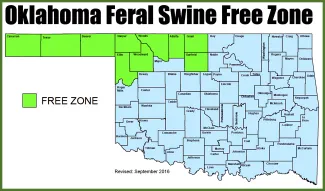
Along with the Wildlife Services Division of the Oklahoma Department of Agriculture, Food and Forestry, the Oklahoma Department of Wildlife Conservation is taking positive steps to address the feral swine situation in Oklahoma.
Feral swine have become a concern across Oklahoma because of their expanding numbers and the damage they inflict to the landscape. Feral swine have been detected in 70 of the state's 77 counties, but they are most prevalent across the southern parts of Oklahoma. They are also most active at night.
Feral hogs congregate in "sounders," as the large groups are called. Each sounder can tear up several acres every night looking for food, which can include cropland, pastures, golf courses and even residential lawns. They will eat about 4 percent of their body weight daily.
Besides destruction of property, other concerns about feral swine are:
- Population growth. Feral swine have high reproductive potential, and piglets become sexually active at about 6 months old. An estimated 600,000 to 1.5 million feral swine are in Oklahoma.
- Disease transmission. Feral swine can be infected with brucellosis and leptospirosis, which can be passed to people. Pseudorabies is found in about one-third of the feral swine population. This disease can spread to dogs, cattle, goats and sheep. Feral hogs also can carry and transmit many other diseases.
- Threat to wildlife: Native species are being stressed by the activities of feral swine. They compete for food resources that also support deer, raccoons, black bears and opossums. Wildlife can contract many diseases from feral swine. Feral swine have few natural predators, and in some cases, the feral swine have begun pursuing wild animals as prey items.
State agencies and landowner groups are highly interested in what can be done to control the feral swine problem. Experts have determined that the best methods are trapping -- especially whole sounder trapping -- and aerial gunning. Other forms of control are largely ineffective and can actually reduce the effectiveness of trapping.
Landowners who have experienced depredation due to feral swine can contact the state Agriculture Department's Wildlife Services Division at (405) 521-4039.
Jeff Pennington, a biologist with the Oklahoma Wildlife Department, said eradication is not realistic on a landscape level. A realistic landscape goal is to slow the spread and reduce the density of feral hogs by the use of trapping and aerial gunning.
The Wildlife Department views feral swine as vermin and maintains they should not be glamorized in any way, even though feral hogs are desired by some people as target animals on hunting lands. Last year, the Wildlife Department declared it illegal to take feral hogs alive from wildlife management areas.
The Wildlife Department supports the Agriculture Department's creation of a "swine free zone" where feral swine cannot be transported, along with measures to require accountability from anyone who transports feral swine in other parts of Oklahoma.
People who are having problems with feral swine without a depredation issue are encouraged to use the most effective methods including trapping. A secondary, less effective option is night shooting of feral swine, which the Wildlife Department believes should be a method of last resort because of the issues it creates that affect safety.
In response to Gov. Mary Fallin's executive order in May 2016, the Wildlife Department has instituted a procedure to allow people to obtain exemptions from existing hunting regulations that prohibit night shooting. The new procedure became operational Nov. 1, and its goal is to provide landowners relief from feral swine while also protecting wildlife.
Only a deed-holding landowner (or a designee with written landowner permission) can register a property for a night-shooting exemption. The exemption procedure provides immediate approval for a landowner (or a designee with landowner's written permission) to shoot feral swine on the property at night.
A landowner shooting feral swine on his property at night must carry his or her exemption number. Anyone else shooting feral swine at night is required to carry the property's exemption number and written permission from the landowner or the landowner's single designee. Rules are more stringent during the 16-day deer gun hunting season, limiting eligible shooters to the landowner, members of the landowner's family, or the landowner's single designee.
Feral hog night-shooting exemptions are available in several ways:
- Filling out information on the Wildlife Department's website, www.wildlifedepartment.com.
- Downloading the "OK Hog Shooting Exemption" mobile app for Apple or Android.
- Calling, e-mailing or texting the game warden based in the county where the property is situated, or the game warden in an adjacent county.
Read the complete feral swine night-shooting exemption rules at www.wildlifedepartment.com/sites/default/files/Feral%20Swine%20Emergenc…